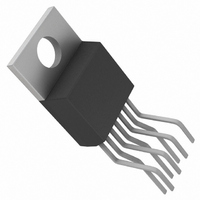LT1581CT7#PBF Linear Technology, LT1581CT7#PBF Datasheet - Page 10

LT1581CT7#PBF
Manufacturer Part Number
LT1581CT7#PBF
Description
IC LDO REGULATOR 10A ADJ TO220-7
Manufacturer
Linear Technology
Datasheet
1.LT1581CT7PBF.pdf
(12 pages)
Specifications of LT1581CT7#PBF
Applications
Converter, Intel Pentium®
Voltage - Input
1.68 ~ 6 V
Number Of Outputs
1
Voltage - Output
1.25 ~ 4.65 V
Operating Temperature
0°C ~ 125°C
Mounting Type
Through Hole
Package / Case
TO-220-7 (Bent and Staggered Leads)
Primary Input Voltage
6V
Dropout Voltage Vdo
430mV
No. Of Pins
7
Output Current
10A
Operating Temperature Range
0°C To +125°C
Msl
MSL 1 - Unlimited
Termination Type
Through Hole
Rohs Compliant
Yes
Lead Free Status / RoHS Status
Lead free by exemption / RoHS Compliant
Available stocks
Company
Part Number
Manufacturer
Quantity
Price
APPLICATIONS
LT1581/LT1581-2.5
where I
I
I
I
Characteristics curves.
The power in the output transistor is equal to:
The total power is equal to:
Junction-to-case thermal resistance is specified from the
IC junction to the bottom of the case directly below the die.
This is the lowest resistance path for heat flow. Proper
mounting is required to ensure the best possible thermal
flow from this area of the package to the heat sink. Thermal
compound at the case-to-heat sink interface is strongly
recommended. If the case of the device must be electroni-
cally isolated, a thermally conductive spacer can be used
as long as the added contribution to thermal resistance is
considered. Please consult Linear Technology’s “Mount-
ing Considerations for Power Semiconductors,” 1990
Linear Applications Handbook, Volume 1 , Pages RR3-1 to
RR3-20. Note that the case of the LT1581 is electrically
connected to the output.
The following example illustrates how to calculate
maximum junction temperature. Using an LT1581 and
assuming:
V
V
V
T
10
OUT
CONTROL
CONTROL
A
CASE-HEATSINK
CONTROL
POWER
OUT
P
P
= 70 C,
OUTPUT
TOTAL
/58 (max).
= 2.5V, Iout = 4A,
CONTROL
(max continuous) = 3.465V (3.3V + 5%),
vs I
is a function of output current. A curve of
= P
(max continuous) = 5.25V (5V + 5%),
= (V
HEATSINK
OUT
DRIVE
= 1 C/W (with thermal compound)
POWER
is equal to between I
can be found in the Typical Performance
U
+ P
= 4 C/W,
OUTPUT
– V
INFORMATION
U
OUT
)(I
OUT
W
)
OUT
/100 (typ) and
U
Power dissipation under these conditions is equal to:
Junction temperature will be equal to:
For the Control section:
For the Power section:
In both cases the junction temperature is below the
maximum rating for the respective sections, ensuring
reliable operation.
Total Power Dissipation = P
P
I
P
P
Total Power Dissipation = 4.09W
T
T
93 C < 125 C = T
T
101 C < 150 C = T
CONTROL
J
J
J
DRIVE
DRIVE
OUTPUT
= 70 C + 4.09W (4 C/W + 1 C/W + 2.5 C/W) = 101 C
= 70 C + 4.09W(4 C/W + 1 C/W + 0.65 C/W) = 93 C
= T
A
= (V
= (5.25V – 2.5V)(69mA) = 190mW
+ P
= (V
= ( 3.465V – 2.5V)(4A) = 3.9W
= I
TOTAL
CONTROL
OUT
POWER
/58 = 4A/58 = 69mA
(
JMAX
JMAX
HEATSINK
– V
– V
for Control Section
OUT
OUT
for Power Section
) (I
)(I
DRIVE
+
OUT
CONTROL
CASE-HEATSINK
)
+ P
OUTPUT
)
+
JC
)













